There is simply something cool about having a hobby that requires you to use tools and to take care of those tools. I know roleplaying has ten-side dice and big fancy cool books, but it’s just
not the same. I understand now how fishing can be enjoyable without actually catching anything. I found myself getting all “geeked-out” while lining up my drawing pencils and sharpening them just right; the point has to be sharp, but a long bit of the lead has to be exposed too. (Pictures and more after the jump) .
Before my holidays, I had decided to go back to basics with my drawing. I had let my basic drawing skills languish over the years. So I got myself a rather excellent book on drawing:
“The Complete Guide to Drawing and Illustration”. It’s a well thought out course, designed to get you drawing full pictures straight away and build up a strong process. Drawing is simply a skill. Art is in the expression and the composition. Everyone can draw so I bugs me a little when someone says “I wish I could draw”, because they can, they’ve just decided they can’t. I shouldn’t get so irate about it though as it’s this exact mentality that made me consider my drawing as a secondary way to creatively express myself (writing became my first). In school there were a number of very talented artists, who were simply better. As I went through school, I ended up comparing my results to their work and found it lacking. Rather than try and improve and ask for help, I did the teenager thing and sulk about it and since then I’ve let my love of drawing dwindle.
The introductory text reminded me of exactly why I like drawing. My wife says that I’m a man of simple pleasures, it’s not what you draw or the end image that is important but it’s the act of drawing that gives you pleasure and capturing “something” in the end result, an expression, a tone or a strange shape. Drawing, in itself, is not complex but is engaging.
So with this long holiday planned, I decided to pack my drawing stuff. I was excited about picking up my pencils and pens again. Chargey is in the east of France, lost in the country side and properly soaked in the summer sun. The house is old, several generations, filled with old paintings and antiques going back to Napoleon times. A great place for finding subjects to draw.
I do have one complaint about the book, but it is minor. All the examples are done by the author, Peter Gray and he’s a professional. His images are wonderful. I’d love to see work done by some example “students”, just to compare with my own. Or maybe that’s a bad thing. Anyway, the first exercise was a mug. A simple exercise in lines and circles. It was fun and simple to do. An interesting side note is that, no where in the book does he suggest using rulers and compasses to get exact shapes, just guidelines and freehand.
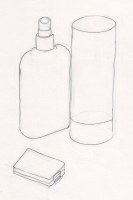
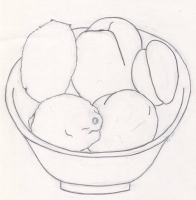
The next exercise then was some basic shapes, rectangles, cylinders, etc. Most drawing books try and get you to draw a cylinder from one hundred and fifty different angles. Following, logically, on from that was organic shapes, such as fruits. It was at this point he introduce “composition”. I never worried about composition before. It is always one of those “advanced” topics in other books. They’d expect you to able to draw whole bodies perfectly before worrying about composition, but Peter makes a good point: a badly drawing picture can still work if the composition is good. It’s something I never considered before, but he’s right. The way objects are laid out and from where you view them is just as important as how well you depict the shapes on the page. If the composition is wrong, the whole picture is wrong before you begin. Shape and composition is actually enough to start doing full drawings but there is two more components missing. One is shadow and tone, the other is…
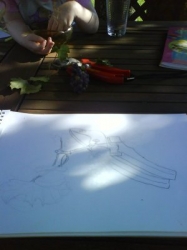
Texture. Why hadn’t anyone pointed this out to me before? It’s something I never explicitly considered yet struggled with to master. When I did character drawings I would get frustrated that the clothes always looked like they were made out of the same plain material. Soft, hard, furry, hairy, rough, grainy, etc. When I drew hair or grass, I couldn’t begin to imagine how to depict all that detail. But it’s much simpler then that. You just need to represent the texture, not all the detail. The line you use to depict the shape and the nature of the details you chose to draw tell the viewer what the texture is. It was like something slotted into place. You can see the image I did to explore texture above. Notice how the cutter seems solid and smooth while the branch is rough. The skill of the art is, not what you draw, but what you chose to draw. Or rather, what you leave out. And armed with that, I started to seeing the visual world around me in terms of what I could leave out to depict it. As we went for walks on Chargey, I’d see a scene, one perhaps I consider drawing and then in my minds eye, I start to “white-out” sections of it, leaving only the necessary details to convey the scene. I started snapping shots with the camera in my mobile because it was handy, and I captured some nice ones actually because I was looking for the detail and composition to describe the scene. Some though came out terrible because a picture of some stones on a wall with bad light doesn’t look great, but would make a great study. Texture, mental note to self. Armed with this I did some more drawings studying just texture and shape, but I’ll talk about those in another post.
Then the book suggests using ink, pens and brushes to do this kind of work (outline drawings) as it’s often quicker to finish. Pens are something I’ve been playing with for years and do love the finishing part of a such drawing, where you’ve done all the scratchy guidelines and then you draw the lines in single confident marks with the pens. I even have professional markers, but I still have barely mastered them. I didn’t have any brushes or ink with me so that’s something I’ll explore now at home, if I get the time. He also suggested a simple tip to give an ink outline drawing a more complete feel: make some of the lines thicker. You can see my effort to do a rose and apple above. I actually think the image would work much much better if I took out the apple and oriented the image vertically. With some computer magic I could do it easily, which is one of the reasons ink appeals to me.
And then I tried some graphic design using block black shapes. As I said I didn’t have any brushes so I used markers to fill it in. And yes, the image above is my Nintendo DS Lite which does happen to be white.

It was fun and fairly quick to do. So you have, composition, shape and texture. There is one component missing. Tone. From shadows and highlights to the natural colours of the objects. It’s been so long since I’ve done a tone drawing and it was great to be given a process to explore shadow again. And the book thought me to use an eraser as a drawing tool, not just something to clean up mistakes. To capture highlights you can use an eraser’s edge, another element of tone that I had previously struggled with it. In the book, Peter suggests filing an eraser to a point, however I have a more elegant solution: use a pencil with one of those rubbers built in on top. You can use the eraser just a like a pencil.

Below you can see the toned drawing I did. And I started to see how I can improve, not just in some abstract way, but in a solid practical way. The scale is slightly off and my angles are not right. You may not see it on first glance but the torch looks bent, the head of the torch looks tilted at a tigher angle than the base. Practice will improve that I hope.
The big thing I learned is not to get so wrapped up in the end product. Enjoy the process of drawing. When I do, the image comes out so much better. If I aim, at least right now, to produce a specific end-result, the drawing suffers. Looking back at some of my previous work, I noticed that some drawings I did for a purpose, like attempts at doing images of other player’s RPG characters, didn’t turn out too well, but ones I did with no set purpose often capture
something. (If you want to check out some of my other artwork, I’ve just installed a neat little plugin for wordpress to manage it:
nextgen-gallery. You can now see all my artwork
here.)
Related Posts:
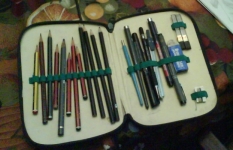



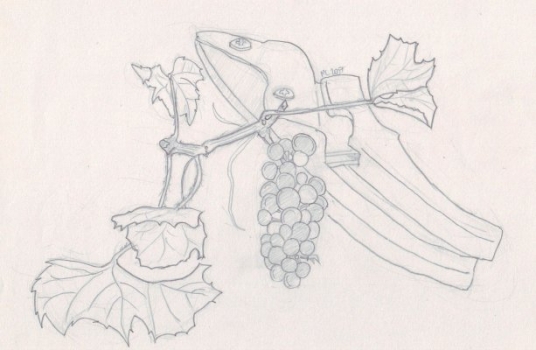

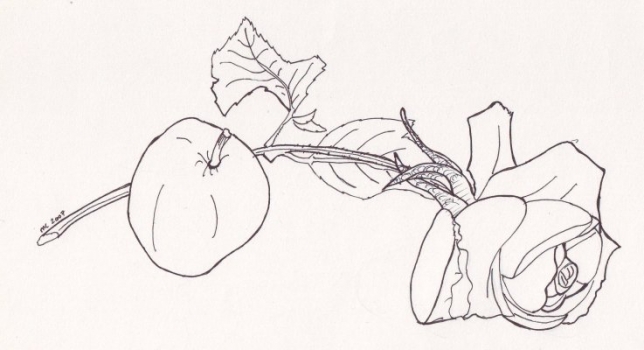
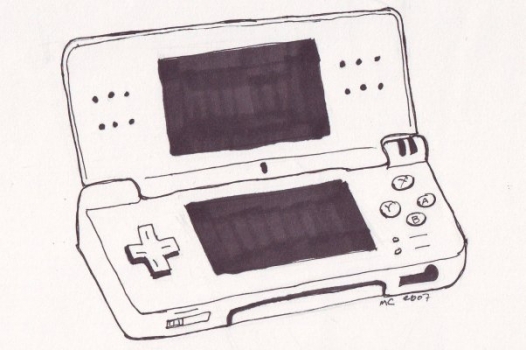
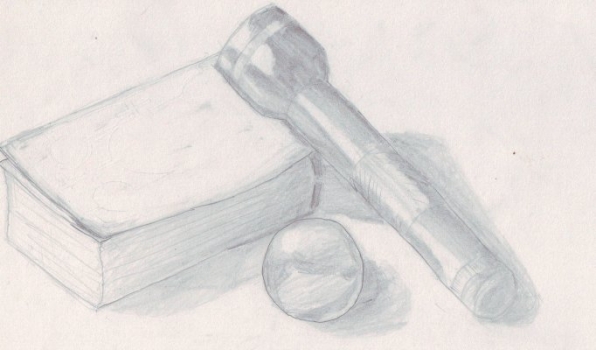
now i see where alice gets her talent
[…] doing drawing exercises on texture, I felt inspired to draw, just for drawing. My daughter and her cousin both have a […]